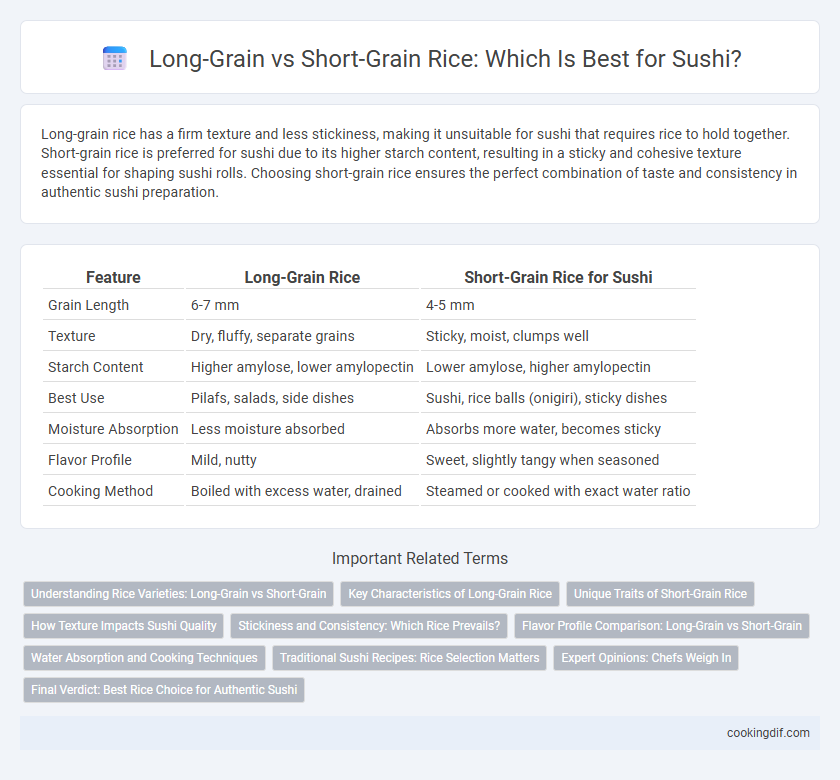Long-grain rice has a firm texture and less stickiness, making it unsuitable for sushi that requires rice to hold together. Short-grain rice is preferred for sushi due to its higher starch content, resulting in a sticky and cohesive texture essential for shaping sushi rolls. Choosing short-grain rice ensures the perfect combination of taste and consistency in authentic sushi preparation.
Table of Comparison
| Feature | Long-Grain Rice | Short-Grain Rice for Sushi |
|---|---|---|
| Grain Length | 6-7 mm | 4-5 mm |
| Texture | Dry, fluffy, separate grains | Sticky, moist, clumps well |
| Starch Content | Higher amylose, lower amylopectin | Lower amylose, higher amylopectin |
| Best Use | Pilafs, salads, side dishes | Sushi, rice balls (onigiri), sticky dishes |
| Moisture Absorption | Less moisture absorbed | Absorbs more water, becomes sticky |
| Flavor Profile | Mild, nutty | Sweet, slightly tangy when seasoned |
| Cooking Method | Boiled with excess water, drained | Steamed or cooked with exact water ratio |
Understanding Rice Varieties: Long-Grain vs Short-Grain
Short-grain rice is preferred for sushi due to its higher starch content, which creates a sticky texture essential for shaping and holding sushi rolls together. Long-grain rice, often less sticky and more separate when cooked, is typically used for dishes requiring fluffy, individual grains rather than the cohesive consistency needed in sushi preparation. Understanding these rice varieties helps sushi chefs select the appropriate type to achieve the traditional taste, texture, and presentation.
Key Characteristics of Long-Grain Rice
Long-grain rice features slender, elongated grains that remain separate and fluffy when cooked, making it ideal for dishes requiring distinct rice grains rather than sticky texture. Its lower starch content compared to short-grain rice results in less stickiness, which is less suitable for sushi that demands cohesive rice for proper shaping. The aromatic varieties of long-grain rice, such as basmati and jasmine, offer distinct flavors but do not replicate the sticky, tender characteristics essential for authentic sushi rice.
Unique Traits of Short-Grain Rice
Short-grain rice used for sushi is characterized by its higher amylopectin content, which creates a sticky and cohesive texture essential for molding sushi. Its plump, rounded grains absorb flavors efficiently, enhancing the overall taste experience. This stickiness also ensures that sushi pieces hold their shape, providing the perfect balance between firmness and chewiness.
How Texture Impacts Sushi Quality
Long-grain rice has a drier, firmer texture with separate grains that can compromise the cohesive quality essential for sushi rolls. Short-grain rice offers a sticky, tender texture that binds well, ensuring optimal sushi texture and flavor balance. The moisture content and starch composition in short-grain rice directly enhance sushi's structural integrity and mouthfeel.
Stickiness and Consistency: Which Rice Prevails?
Short-grain rice prevails in sushi preparation due to its higher amylopectin content, which provides superior stickiness and consistency essential for forming sushi rolls and nigiri. Long-grain rice, with its higher amylose content, tends to be fluffier and less sticky, making it unsuitable for sushi that requires the rice to hold together firmly. The cohesive texture of short-grain rice ensures the perfect balance of moisture and adhesion, critical for authentic sushi experience.
Flavor Profile Comparison: Long-Grain vs Short-Grain
Short-grain rice offers a sweet, buttery flavor with a sticky texture essential for authentic sushi, enhancing the overall taste experience by holding ingredients together. Long-grain rice, while less sticky and more aromatic with a nutty undertone, lacks the cohesive texture required for traditional sushi rolls. The unique flavor profile and texture of short-grain rice make it the preferred choice for sushi chefs aiming for balance and authenticity in every bite.
Water Absorption and Cooking Techniques
Long-grain rice absorbs less water compared to short-grain rice, resulting in a drier and fluffier texture unsuitable for sushi's sticky consistency. Short-grain rice has a higher amylopectin content, allowing it to absorb more water and achieve the desired stickiness essential for sushi preparation. Proper rinsing, soaking, and precise water-to-rice ratios are crucial techniques to maximize short-grain rice's water absorption and texture for authentic sushi.
Traditional Sushi Recipes: Rice Selection Matters
Long-grain rice lacks the necessary stickiness and moisture content essential for traditional sushi, making it unsuitable for authentic recipes. Short-grain rice, specifically sushi rice or Japonica varieties, provides the ideal texture and adhesive quality critical for molding sushi rolls and nigiri. Selecting the right rice type significantly influences the flavor balance and structural integrity of classic sushi dishes.
Expert Opinions: Chefs Weigh In
Expert chefs emphasize that short-grain rice is essential for authentic sushi due to its higher starch content, which results in the sticky texture needed to hold sushi together. Long-grain rice, with its drier and fluffier characteristics, lacks the necessary adhesion and is generally avoided in sushi preparation. Culinary experts consistently recommend Japanese short-grain rice varieties such as Koshihikari for achieving the ideal balance of moisture and stickiness in sushi.
Final Verdict: Best Rice Choice for Authentic Sushi
Short-grain rice is the best choice for authentic sushi due to its higher starch content, which creates the sticky texture essential for sushi to hold together. Long-grain rice lacks this stickiness and tends to be drier and fluffier, making it unsuitable for traditional sushi preparation. The ideal sushi rice combines a balance of moisture and stickiness, with short-grain varieties like Japonica rice being preferred by sushi chefs worldwide.
Long-grain rice vs short-grain rice for sushi Infographic

 cookingdif.com
cookingdif.com